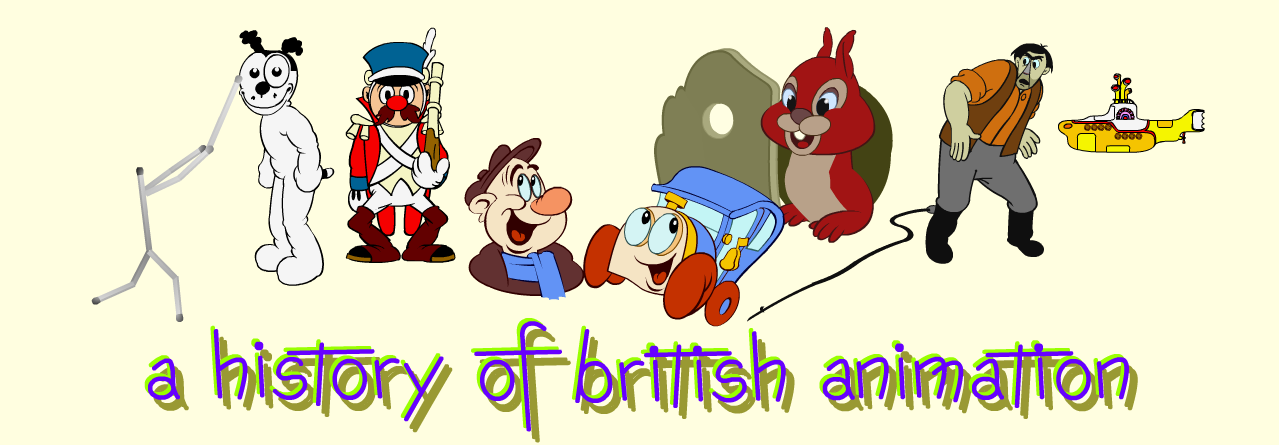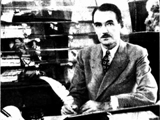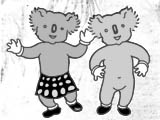

|
 | DENNIS CONNELLY LTD(1934-1936) |  |
||
The Mystery of the Disappearing KoalasOn Friday 1 November 1935 the following item appeared in the Townsville Daily Bulletin, Queensland, Australia: MOVIE CARTOON. Australia had first read about Connelly's cartoon bears some 14 months earlier. On Saturday 1 September 1934 the following item appeared on page 3 of the Mail (Adelaide): Native Bears Caper In New Film Cartoon The Tatler Theatre, London, was a 650-seater, and it is possible that this was a trade show, rather than a public performance. The same story appeared on Monday in the Adelaide Courier-Mail and was picked up by other Australian papers during the week. On 11 December The Daily Standard (Brisbane) was able to update the story: TEDDY BEARS IN FILMS. London, Monday. Connelly, who started operations with a small staff at Soho, is now installed in a modern West-street studio with 40 artists,
the majority [of] whom are girl draughtsmen trained at art schools. Despite the promise of distribution there is no evidence of this taking place or of MGM registering the film Dick Whittington. It is possible they decided to wait until the next film was completed, in order to be able to launch a series. Dennis Connelly was an Australian political cartoonist who had worked in London after WWI, returning to Melbourne in 1919 to take over from David Low on the Australian magazine The Bulletin when the latter came to London to join The Star. In 1930 Connelly once more set his sights on London, making several trips back and forth, finally settling here in July 1933. By the beginning of 1934 he had set up a studio in Soho to make a cartoon film. He recruited a team of artists, many straight from art school, and many women (in both cases this may have been a way to get trained talent for modest wages) to assist in animating, inbetweening, tracing and painting. One young recruit was Joy Batchelor, a talented artist with a fluid line and a propensity for speaking her mind. She began working as an inbetweener, but was promoted to animator after objecting that the drawings she was being given weren't moving properly. She taught herself to animate, and by the end of the summer of 1935 was earning 5 guineas a week and teaching others. In an interview with Kay Mander in 1989 she recalled the the rostrum cameraman was Adrian Jeakins. When I first wrote this page I had been unable to find any reference to Billy and Tilly in the British press. I have since found three stories, one in the Belfast Telegraph (31 August 1934) reporting that 'Mr. Connelly's first cartoon, "Billy and Tilly" is ready for the trade', one in the Kinematograph Weekly (10 January 1935) announcing M-G-M's forthcoming release of the Dufaycolor cartoon Dick Whittington (but not mentioning Billy and Tilly), and one in the Birmingham Sunday Mercury (11 August 1935) by columnist Harold A Albert promoting the Koalas and Connelly's studio. Despite the coverage in the Australian press, neither the characters Billy & Tilly nor the film Dick Whittington appear in Denis Gifford's Filmography. He lists Robin Hood, the second of the Billy & Tilly films, but is unaware that it features the Koalas. Denis Gifford speculatively attributes to Dennis Connelly (misspelling it as Connolly) two cartoons made for Champion Productions (apparently the feature production company run by Producer Basil Humphrys) although this may just be because they were distributed by MGM, who distributed the only known product of the studio, Robin Hood, the following year. The Eternal Triangle (5 mins) was reviewed in the Daily Film Renter 3 December 1934: "A British cartoon based on a neat idea, with 'spot' and 'plain' billiard balls vieing for the love of dainty Miss 'Red', Effectively drawn but a trifle laboured." and it has equally faint praise for The Lost Ball (6 mins) reviewed the same day: This British cartoon effort narrates the adventures of a golf ball in search of its mate, who has got lost in the rough. A novel idea, but might be better developed." (NB: I must point out that Gifford assigns these reviews to the opposite titles. This may have been the way they appeared in the original magazine, but I believe it to have been an error, and have reassigned the titles to the plot descriptions that best suit them.) It is possible, if these really are are by Connelly, that they were made as simpler cartoon exercises before the studio embarked on the first of the Billy & Tilly films, or perhaps they were made to fulfill the MGM contract, since progress on the Koala films was so slow. However, since the involvement of Connelly is uncomfirmed, I have not included these two films in the Filmography below. It is presumably as a result of the successful completion of Dick Whittington that the company Dennis Connelly, Ltd was registered in September 1934, with a modest share capital of £100 (equals about £6000 in 2015). The registered office was at 60 Greek St, in the heart of Soho, but the new company soon moved into more spacious accommodation at 1 West Street - above the Ivy Restaurant, since the 1920s a popular haunt for theatrical celebrities. *I can find no mention of online in the UK press or trade mags,*On 17 January 1935 the Melbourne weekly magazine Table Talk's gossip columnist "Penelope", whose "letter from London ... discusses the doings of Australians in London," included the following item: Billy and Tilly Bear
"Penelope" was a little flattering with Connelly's age - he was about 43 at the time, and had been 21 when he had first come to London as a student in October 1912 (according to the ages given in the records of his steamship voyages). The item was accompanied by a photograph of Dennis "at work", posing at a drawing board with a quill pen (as seen above). Harold A Albert, in his diary column, adds more information: His experiments began in a shabby street in the heart of Soho. His rickety studio had a sloping floor, cracked boards, holes in the roof and no fire. The sole advantage was that it didn't cost very much and it enabled Connelly to get down to the job. Some interesting maths problems here. The film in progress would be the second M-G-M Billy & Tilly film, Robin Hood, so how does Albert make it the fourth? Are the golf ball and billiard ball cartoons included? Or is the first film the jerky failure, possibly titled Billy & Tilly, and with Robin Hood nearing completion was a further film in the planning stages? And regarding the staff, if the round figures are to be accepted 40 of the total 50 were creating the drawings (Joy Batchelor recalls they were inking them straight onto cels as they animated) then the remaing 10 (or 9 if the cameraman is included in the 50) were painting the cels and creating the backgrounds.
Work on Robin Hood seems to have progressed faster than on Dick Whittington, and Kinematograph Year Book 1936 lists it as registered on 4 November 1935 by MGM, maker's name Dennis Connelly. As mentioned at the start the "Film Critic of the Daily Telegraph" (the source of the story that appeared both in the Townsville Daily Bulletin, as quoted, and in the Sydney Morning Herald) reported that the first showing was booked for the same date that the Australian papers were published, Friday 1 November 1935, at the Empire Theatre, MGM's Leicester Square showcase cinema. Connelly had a distribution deal and at least one, if not two completed Billy & Tilly films. So what happened to the Koalas? The answer might lie in the telling phrase "the outlay of a private fortune". The Sydney Morning Herald story is almost identical to the Townsville Daily Bulletin's, but names the "new British color process" as Dufaycolor. Dufaycolor was indeed a new colour process, a Franco-British system unveiled in 1932, which had been used by Len Lye for 2 animated films in 1935, but there was also another possible candidate. On 24 February 1936 The Argus (Melbourne) published this item: Film Cartoons of Koalas On a world tour, Sir George Hill, who is chairman of Dennis Connelly, Ltd., the company which is preparing animated film cartoons featuring two Australian koalas, arrived in Melbourne by the Orient liner Orion last night. He said that the cartoons would be sent to Austraslia as soon as possible. Mr Dennis Connelly is an Australian artist, who has 50 artists helping to produce the cartoons. Sir George subsequently gave a fuller interview, published in the Barrier Miner (NSW): CHALLENGE TO DISNEY Sir George Rowley Hill, Baronet, aged 71 according to the Orion's passenger list, was not only chairman of Dennis Connelly, Ltd but would soon become chairman of British Ondiacolor, Ltd, which would be set up in the coming June to promote the production of films in the Ondiacolor process, which had been been in development for the last few years. I wonder if Connelly's studio had been backed by the developers of Ondiacolor. Perhaps the release print of Robin Hood was in Dufaycolor because the Ondiacolor prints were not sharp enough. Note that Sir George is not promoting the Billy and Tilly series into which the "private fortune" had been poured, but a new series featuring an unnamed boy and girl. The version of the story published in The Age (Melbourne) describes them as "puppets" - whether this means the series would be model animation is debatable. However, Sir George was aware that Billy and Tilly had had thair day. No review of Robin Hood has come to light, but whatever the critical reception of the cartoon, the returns from it were not sufficient to pay the company's debts, let alone fund further production. This was a fate suffered by many of the animation companies that set out to compete with the US cartoon studios - they discovered too late that the returns were slow to come in and always less than expected, while the existance of a distribution contract was not sufficient incentive for further investment into a company with heavy debts. Whether the "private fortune" had been Connelly's, his wife's, or Sir George's, the time had come to turn off the tap. What Sir George did not mention was that Dennis Connelly, Ltd had gone into receivership on the 3 January 1936 and the staff was disbanded. I suspect that future production was to be funded by British Ondiacolor, Ltd, cartoons being a good vehicle for promoting colour processes as the colour only needed to be attractive, rather than naturistically faithful. But there is no sign of any further cartoon production. British Ondiacolor, Ltd produced a few live-action 1-reel documentaries during 1937 (Madeira; Through Beautiful Britain No. 1; Through Beautiful Britain No. 2) but the system could not beat Dufaycolor or Gasparcolor, and the company went into receivership on 23 April 1938. Dennis Connelly made one further animated cartoon - a topical colour insert for Sound City's attempt to break into the Weekly Newsreel market, National News. Gifford quotes a very negative review of the cartoon from the Daily Film Renter 12 October 1937, although this may just have been part of a review of the Newsreel that was negative in toto: the established Newsreels had banded together in an attempt to crush this unwanted competition. Their efforts were successful - National News was suspended after the first reel, and terminated in February 1938. The Connellys remained in London throughout WWII, but finally returned to Australia in 1948. Animator Richard Taylor wrote this report of Joy Batchelor's reminiscence of her time at Dennis Connelly, Ltd: "I was an inker, but it was all so primitive that when you were inking you were also animating straight onto cel. Can't remember the name of the company but the man was an Australian cartoonist who thought he was going to make his fortune with a couple of Koala bears but he didn't. He just lost other people's money." Eyebrows up. Naughty look. "Ten of us worked there for three years and we learned to animate after a fashion." In a recorded interview reminiscing with Kay Mander in 1989, Joy remembered Connolly's name, and was grateful to him for the experience that enabled her to answer the small ad for an animator placed by John Halas. But she was typically candid about the films: "He made two actually, terribly bad."..."They only had a short life and a gay one. He had very good connections, this bloke, and our film - which was about two little horrible bears, koala bears - lasted three days at the Empire, and it was hooted off!"
|
Filmography | ||||
| Billy and Tillie(?) | 1934 (abandoned first attempt?) | |||
|---|---|---|---|---|
| Producer: | Dennis Connelly | |||
| Animators: | unknown | |||
| Distributor: | none | |||
| Sound: | Visatone | |||
| Colour: | Colour, process unknown | |||
| Length: | unknown | |||
| Dick Whittington | 1935 (no release recorded) | |||
| Producer: | Dennis Connelly | |||
| Animators: | Joy Batchelor, others unknown | |||
| Distributor: | none | |||
| Sound: | Visatone | |||
| Colour: | Colour, process unknown | |||
| Length: | 8 min | |||
| Robin Hood | 1935 | |||
| Producer: | Dennis Connelly | |||
| Animators: | Joy Batchelor, others unknown | |||
| Distributor: | MGM | |||
| Sound: | Visatone | |||
| Colour: | Colour, process unknown | |||
| Length: | 800 ft (9 min) | |||
| Released: | November 1935 | |||
Links to Other Sites | ||||
Trove Archive - Table Talk 17 Jan 1935, p12: Letter from London, with item on Dennis Connelly. | ||||
BECTU History Project Joy Batchelor interview: refers to Dennis Connelly from end of p.2 to start of p.4. | ||||
Peter Hale
Last updated 2024
|